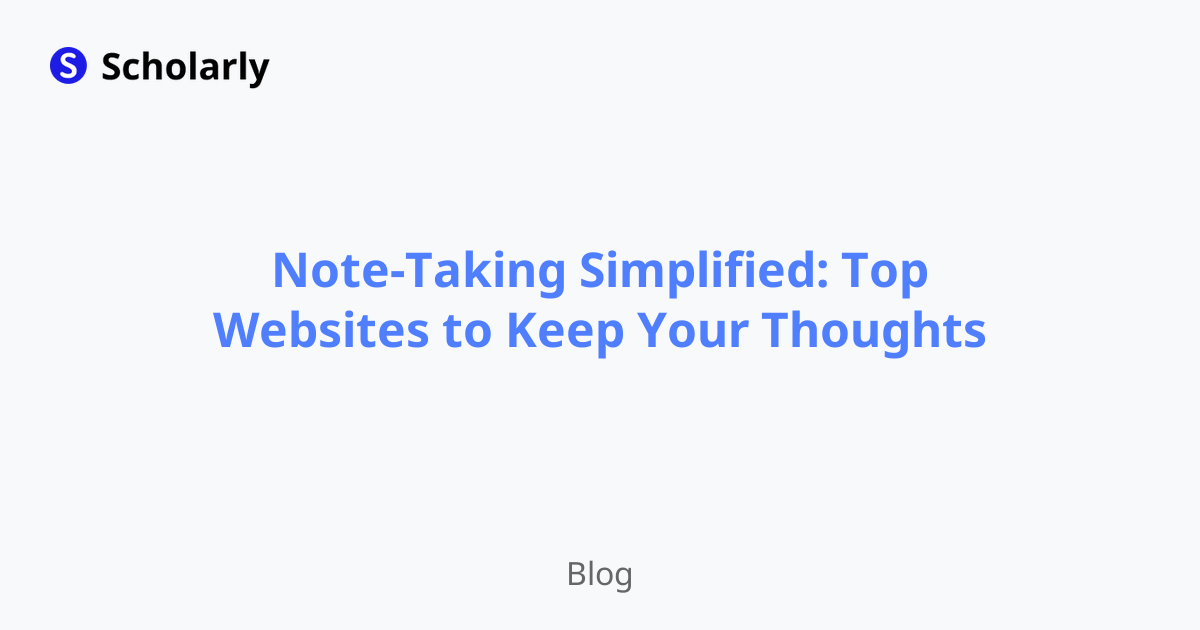Note-Taking Simplified: Top Websites to Keep Your Thoughts
Explore the top websites for simplified note-taking and discover the best resources to organize and keep your thoughts with our comprehensive guide. Learn the history, benefits, and best practices, and find out how AI impacts note-taking and study habits.

Introduction
Note-taking is at the heart of learning and productivity, and in the digital age, it has been revolutionized by a myriad of web-based services. In this article, we delve into the history of note-taking, its current state, and future possibilities, showcasing top websites that make it easier to record and organize thoughts. We'll also explore the benefits, significance, and best practices for note-taking, as well as compare various tools and tackle the pros and cons each offers.
Past State of Note-Taking
Previously, note-taking was predominantly done using pen and paper. However, the advent of digital devices introduced software like Microsoft Notepad and Word, Google Docs, and Evernote, transforming how we capture and store information. Long before these modern amenities, ancient civilizations used various materials ranging from tablets, parchment, to paper, indicating the timeless importance of recording knowledge.
Current State of Note-Taking
Today, we have access to sophisticated applications like Scholarly, OneNote, and Bear, each providing unique features for a tailored note-taking experience. Scholarly stands out with its AI-powered tools such as text completion, flashcard creation, and transcribing capabilities, which you can explore by signing up here (https://scholarly.so/register).
Future State of Note-Taking
Note-taking will continue to evolve with AI advancements. AI could predict and suggest content, create summaries, and even craft entire research papers. Scholarly is already on this path, offering features like AI auto-complete and an AI tutor for studying flashcards, indicating a trajectory towards a highly integrated AI note-taking experience.
Benefits
- Organization: Digital tools help streamline the organization of notes, making it easier to search and retrieve information.
- Accessibility: Remote accessibility allows users to access notes wherever they are, facilitating continuous learning and productivity.
- Collaboration: Many of these websites and apps offer collaborative features, enabling group projects and the sharing of knowledge.
- Integration: Integration with other apps and services increases the utility of note-taking tools.
- Innovation: Users can now leverage features like text-to-speech, flashcard creations, and transcription of visual material into the editable text, seen in Scholarly.
Significance
The ability to effectively capture, manage, and retrieve notes is paramount in education and various professional fields. From the ancient Library of Alexandria to modern universities and corporations, note-taking has been central to preserving and disseminating information. The significance is reflected in the continuous development and upgrading of note-taking applications to enhance user experience.
Best Practices
- Consistency: Establishing a consistent method for taking and organizing notes is key for long-term retrieval.
- Adaptability: Adapting note-taking methods to fit different contexts is necessary for effective learning.
- Technology Use: Leveraging technological advancements, such as AI-powered tools provided by Scholarly, can significantly enhance note-taking practices.
- Reviewing: Regularly reviewing notes helps in retention and understanding.
- Incorporation of Multimedia: Using various media types, such as text, images, and audio, can make notes more comprehensive and memorable.
Pros and Cons
Pros:
- Improved Learning: Digital note-taking can augment learning experiences.
- Ease of Use: The intuitive interface of apps like Scholarly improves the user experience.
- Customizability: Users can tailor their note-taking process to their individual needs. Cons:
- Dependency: Overreliance on digital tools can lead to a deterioration of manual note-taking skills.
- Privacy Concerns: Storing notes online raises concerns about data privacy and security.
Comparison
Comparing various tools reveals diverse functionalities that cater to different user preferences. Scholarly's integration of AI for studying and note-taking sets it apart from conventional tools like Evernote and OneNote. For those interested in exploring Scholarly, remember to sign up at Scholarly (https://scholarly.so/register) for a firsthand experience.
AI Impact
AI is increasingly intersecting with education technology, offering assistance in creating flashcards, summarizing texts, and even conducting research. Its applications in note-taking are vast, with tools like Scholarly pushing the envelope in utilizing AI to shape future learning and productivity platforms.
Conclusion
We've examined an array of factors that highlight the importance, benefits, and implications of contemporary note-taking websites. With tools like Scholarly, users are empowered to harness AI functionalities, making the process of note-taking more efficient and adaptable to individual needs. The ongoing evolution of these tools signals a future where taking notes might be as simple as thinking aloud, captured and organized by AI-powered platforms."
Try Our Popular AI Study Tools
Transform your study materials into interactive learning experiences with our most popular AI-powered tools:
PDF to Flashcards
Convert lecture notes and textbooks into study flashcards instantly
Text to Flashcards
Turn any text or notes into comprehensive flashcard sets
Image to Flashcards
Convert diagrams and handwritten notes into digital flashcards
YouTube to Flashcards
Generate flashcards from educational video content



